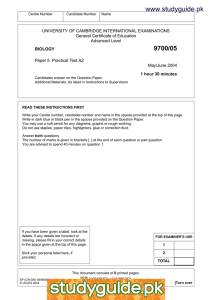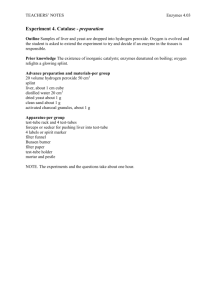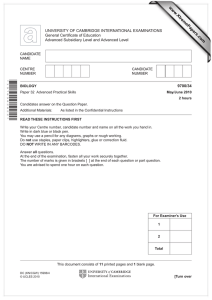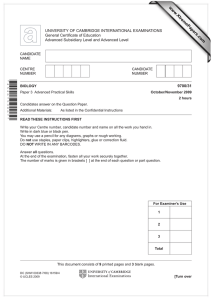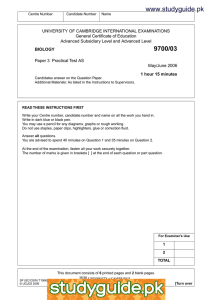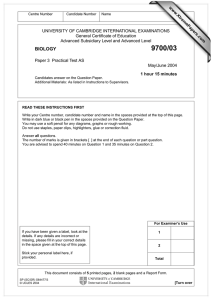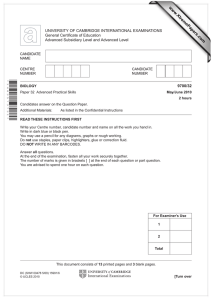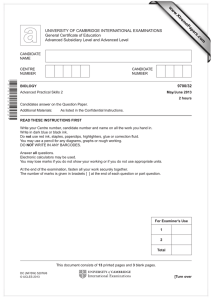9700/05
advertisement
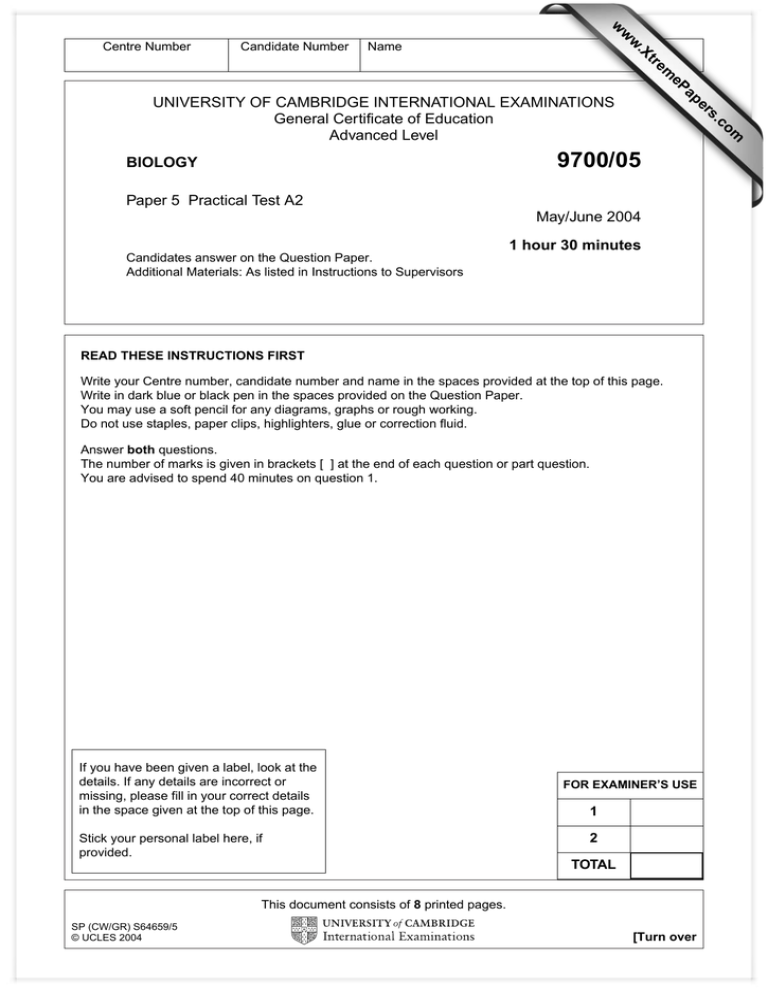
w w Name ap eP m e tr .X Candidate Number w Centre Number om .c s er UNIVERSITY OF CAMBRIDGE INTERNATIONAL EXAMINATIONS General Certificate of Education Advanced Level 9700/05 BIOLOGY Paper 5 Practical Test A2 May/June 2004 1 hour 30 minutes Candidates answer on the Question Paper. Additional Materials: As listed in Instructions to Supervisors READ THESE INSTRUCTIONS FIRST Write your Centre number, candidate number and name in the spaces provided at the top of this page. Write in dark blue or black pen in the spaces provided on the Question Paper. You may use a soft pencil for any diagrams, graphs or rough working. Do not use staples, paper clips, highlighters, glue or correction fluid. Answer both questions. The number of marks is given in brackets [ ] at the end of each question or part question. You are advised to spend 40 minutes on question 1. If you have been given a label, look at the details. If any details are incorrect or missing, please fill in your correct details in the space given at the top of this page. Stick your personal label here, if provided. FOR EXAMINER’S USE 1 2 TOTAL This document consists of 8 printed pages. SP (CW/GR) S64659/5 © UCLES 2004 [Turn over 2 1 You are to investigate some reactions that occur in live yeast cells after they have been immobilised in alginate ‘beads’. First make 15 to 20 yeast-alginate beads. Proceed as follows: • • • • Place 3 cm3 of well-stirred yeast suspension into a test-tube. Add 3 cm3 of alginate solution to the test-tube, and stir well with a glass rod. Place about 3 cm depth of calcium chloride solution into a small beaker. Use the glass rod to drop some of the yeast-alginate mixture from the test-tube into the beaker of calcium chloride solution, as shown in Fig. 1.1. glass rod yeast-alginate mixture calcium chloride solution about 3 cm Fig. 1.1 • • • • • A bead of about 5 mm in diameter should be produced. Stirring the yeast-alginate solution often with the glass rod, repeat this procedure to produce 15 to 20 similar beads of which you will need 8. Stir the calcium chloride solution for a few minutes until at least 8 of the beads sink to the bottom of the beaker. Remove and discard any that are obviously different in size, distorted in shape or that float. The beads can be picked up gently using a pair of forceps. © UCLES 2004 9700/05/M/J/04 For Examiner’s Use For Examiner’s Use 3 (a) Place 5 cm3 of 1.0 mol dm–3 hydrogen peroxide solution into a test-tube. Hydrogen peroxide is corrosive. Use appropriate safety precautions, and if any comes into contact with your skin wash immediately under cold water. Drop one of the yeast-alginate beads into the test-tube and observe it for 1 minute. Repeat this procedure using a fresh bead and a test-tube with 5 cm3 distilled water. (i) Record your observations of the behaviour and appearance of the beads. ................................................................................................................................... ................................................................................................................................... ................................................................................................................................... ...............................................................................................................................[3] (ii) Explain your observations in (a) (i) as fully as possible. ................................................................................................................................... ................................................................................................................................... ................................................................................................................................... ................................................................................................................................... ...............................................................................................................................[4] © UCLES 2004 9700/05/M/J/04 [Turn over For Examiner’s Use 4 (b) Read all the instructions before beginning this part of the experiment. Before you start, prepare a table in the space below in which to record your readings and mean values. Repeat your procedure in (a) (i) using fresh 1 mol dm–3 hydrogen peroxide solution. Start timing as soon as the bead touches the bottom of the test-tube. Stop the timing as soon as the bead rises from the bottom of the test-tube. Remove the bead from the solution using the wooden splint. Retain the solution. (i) Record this time interval in seconds in your table. Repeat this measurement twice more, using a fresh yeast bead each time. Record the time intervals in your table. Make up 10 cm3 of 0.2 mol dm–3 hydrogen peroxide solution in a beaker. Place 5 cm3 of this solution into a clean test-tube. (ii) Repeat the procedure in (a) (i) this time using the 0.2 mol dm–3 hydrogen peroxide solution. Record three timed measurements in your table. For each measurement use a fresh yeast bead. Calculate the mean time taken for the bead to begin to rise for the 1 mol dm–3 and 0.2 mol dm–3 hydrogen peroxide solutions. [5] (iii) Outline the safety precautions you took in carrying out this experiment. ................................................................................................................................... ...............................................................................................................................[1] © UCLES 2004 9700/05/M/J/04 For Examiner’s Use 5 (iv) Explain the results you recorded in the table. ................................................................................................................................... ................................................................................................................................... ................................................................................................................................... ...............................................................................................................................[3] (c) Plan, but do not carry out, an investigation to determine the effect of temperature on the rate of decomposition of hydrogen peroxide by a suspension of yeast. .......................................................................................................................................... .......................................................................................................................................... .......................................................................................................................................... .......................................................................................................................................... .......................................................................................................................................... .......................................................................................................................................... .......................................................................................................................................... .......................................................................................................................................... .......................................................................................................................................... .......................................................................................................................................... .......................................................................................................................................... ......................................................................................................................................[6] [Total : 22] © UCLES 2004 9700/05/M/J/04 [Turn over For Examiner’s Use 6 2 K1 is a stained transverse section through a dicotyledonous plant. Examine the specimen using the low-power of your microscope. (a) Make a large, labelled, plan diagram to show the distribution of tissues. [4] © UCLES 2004 9700/05/M/J/04 For Examiner’s Use 7 (b) State from which part of the plant the section was taken. ......................................................................................................................................[1] (c) Make a high-power drawing of two cells, one from a water conducting tissue and the other from a storage tissue. [3] [Total : 8] © UCLES 2004 9700/05/M/J/04 8 REPORT FORM The teacher responsible for this subject is asked to answer the following questions. (a) Was the candidate physically handicapped in drawing or in using a microscope or is the candidate colourblind? If so, give brief details. (b) Was the candidate handicapped by deficient material or apparatus? If so, give brief details. (c) Was it necessary to make any substitutions for the materials sent from Cambridge, or recommended in the confidential instructions? If so, give brief details of the circumstances. (d) Any comments. Signed ...................................................... N.B. Information that applies to all candidates need be given on the first candidate’s answer book only. Every reasonable effort has been made to trace all copyright holders. The publishers would be pleased to hear from anyone whose rights we have unwittingly infringed. University of Cambridge International Examinations is part of the University of Cambridge Local Examinations Syndicate (UCLES), which is itself a department of the University of Cambridge. 9700/05/M/J/04
